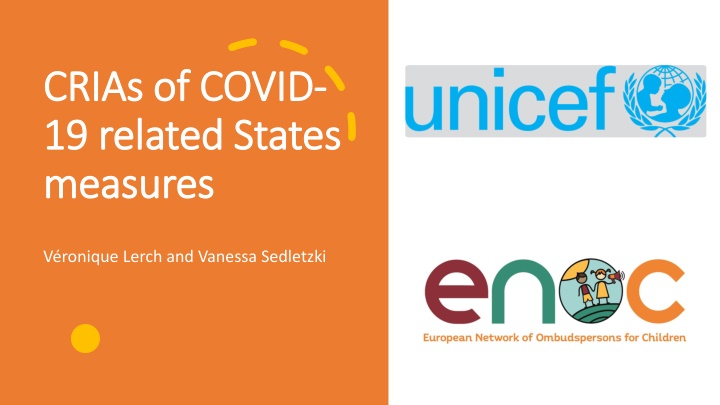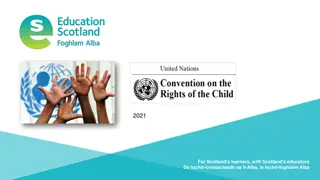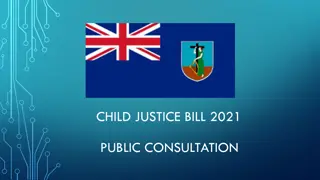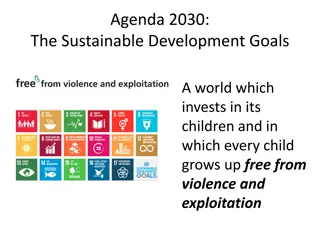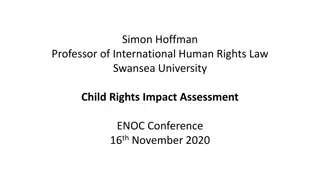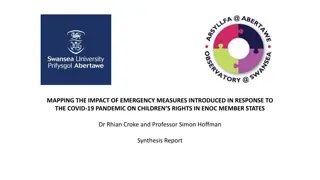Child Rights Impact Assessment on COVID-19 Measures in Multiple States
Child Rights Impact Assessment (CRIA) focuses on evaluating the effects of laws, policies, and actions on children's rights during the COVID-19 pandemic. This project examined measures implemented in various countries to combat the spread of the virus and safeguard the interests of children and young people. The methodology followed ENOC guidelines, with consultants working on assessing both negative and positive impacts on child rights. The assessment spanned from February to October 2021 and covered countries like Albania, Bulgaria, Cyprus, and others.
Download Presentation

Please find below an Image/Link to download the presentation.
The content on the website is provided AS IS for your information and personal use only. It may not be sold, licensed, or shared on other websites without obtaining consent from the author.If you encounter any issues during the download, it is possible that the publisher has removed the file from their server.
You are allowed to download the files provided on this website for personal or commercial use, subject to the condition that they are used lawfully. All files are the property of their respective owners.
The content on the website is provided AS IS for your information and personal use only. It may not be sold, licensed, or shared on other websites without obtaining consent from the author.
E N D
Presentation Transcript
CRIAs of COVID CRIAs of COVID- - 19 related States 19 related States measures measures V ronique Lerch and Vanessa Sedletzki
CRIA is a process, tool and report which supports a systematic assessment and communication of the impact of a proposal or measure on the rights, needs and interests of children and young people. CRIA focuses on how children s rights were or may be affected by the decisions and actions of governments, institutions and others in the areas of law, policy and practice. ENOC Synthesis report Child Rights Impact Assessment November 2020
CRIA/CRIE CRIA/CRIE Ex ante CRIA provides an opportunity to examine the potential impacts on children and young people of laws, policies, programmes and services as they are being developed and, if necessary, suggest ways to avoid or mitigate any negative impacts. Ex post Child Rights Impact Evaluation (CRIE) is conducted after a decision has been made or an action has been taken and provides an opportunity to consider the intended or unintended effect those legislative changes, budget decisions, policies, programmes or services have had on children. Where necessary, the CRIE can propose what changes are needed to comply with the UNCRC.
What What was was this this project project about? about? Where: Albania, Bulgaria, Cyprus, Georgia, Greece, Ireland, Kygysztan, Moldova, Montenegro, Serbia, The Netherlands, Tajikistan, Uzbekistan What: Assessment of the impact of measures taken in order to contain the transmission of the virus and contain the expansion of COVID-19. How: Methodology developed by ENOC based on previous work. Support of 2 consultants for the whole project and national consultants hired. When: February-October 2021
Methodology Methodology Methodology based on the ENOC Common Framework of Reference on Child Rights Impact Assessment (CFR) and follows the 8 steps Refers only to CRIA even though in most cases it will probably be a CRIE (Child Rights Impact Evaluation conducted after the decision has been made or an action has been taken) A CRIA should not be limited to evaluate the potential or actual negative impact on child rights but also the positive or neutral impact.
Approach Approach and and depth depth of the CRIA of the CRIA Great diversity of approach Scope: some countries chose one specific measure affecting a very small number of children, some chose to look at a larger set of measures and how they impacted all children in the country All countries used a mixed methodology with desk review and consultations with stakeholders as well as consultation with children (only one country did not consult with children)
Groups of Groups of children children some some CRIAs CRIAs focused focused on on The measure will impact some children more than others. It is therefore of crucial importance to differentiate the impact among various groups of children and to identify which groups are more affected (importance of disaggregated data) Children in alternative care Children in conflict with the law Children affected by migration (3 countries from Central Asia) Children with disabilities Children on the move .
Child Rights Child Rights involved involved Education (closure of schools, online learning) Mental Health Right to play and recreational activities Alternative care Protection from violence
Challenges in Challenges in undertaking undertaking this this CRIA CRIA New tool, which has not been used before nationally Lack of experience and support from other stakeholders Distinguishing it from a situation analysis and selecting one or a few measures and relating the impact on child rights to the measure Lack of evidence (especially on certains areas such as violence) Linking the impact to the measure Meaningful child participation: ethical review of the methodology, timing (summer holidays ), time pressure COVID-19 restrictions that made the data collection more challenging (E.g. Many countries used online surveys or did online interviews)
Preliminary Preliminary lessons lessons learned learned
Follow Follow- -up to the initiative up to the initiative Publication of the national CRIA reports Some ombudsperson s offices will develop their own CRIA methodology
